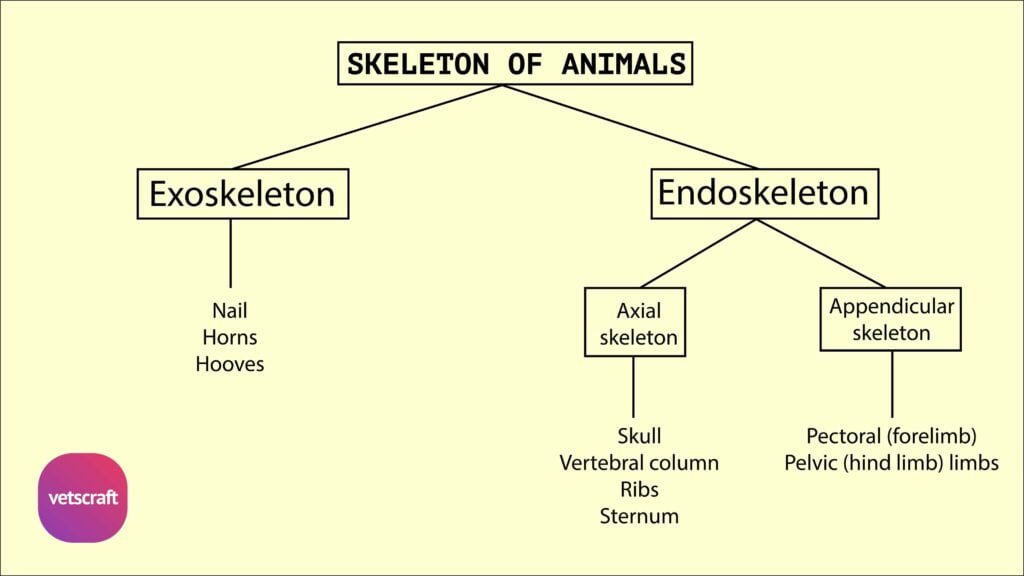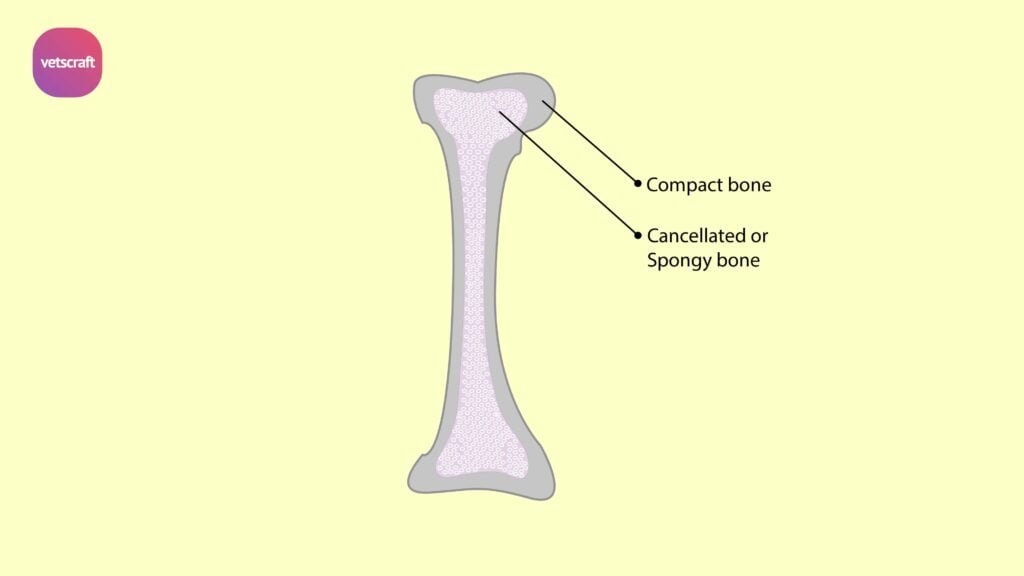TABLE OF CONTENTS
Classification of Bones in Animals
Classification of bones refers to the systematic grouping of bones based on their general shape and function. Bones in the body are categorized into different types—such as long bones, flat bones, short bones, sesamoid bones, irregular bones, and pneumatic bones—each having distinct characteristics, structures, and roles.
Classification of bones is based on their general shape and function as follows:
- Long bones
- Flat bones
- Short bones
- Sesamoid bones
- Irregular bones
- Pneumatic bones
1. Long Bones

Long bones have an elongated cylindrical part, the shaft or diaphysis, and two expanded extremities, or epiphyses. The shaft encloses the medullary cavity, which in life is occupied by yellow marrow.
The wall consists of dense compact bone of considerable thickness in the middle part of the shaft but becomes thinner towards the extremities. Inside the compact bone, there is a thin layer of spongy bone lining the medullary cavity.
Each epiphysis consists of spongy bone covered by a thin layer of compact bone. The spaces in the cancellated bone of the epiphyses are occupied by red marrow.
Long bones are found in the limbs and act as pillars for support and as levers. For example, humerus and femur bones.
Some long bones do not develop completely, and their medullary cavity is very small or even absent, which are called aborted long bones. Examples include the ulna of the horse.
Some bones, though long, do not have a medullary cavity and are sometimes referred to as elongated bones. An example is ribs.
2. Flat Bones

Flat bones are expanded in two directions. They are plate-like, affording a large surface area for the attachment of muscles and protection of subjacent structures.
The flat bones are made up of varying thicknesses of spongy bone between two layers of compact bone. Examples of flat bones are the scapula and flat bones of the skull like the frontal, parietal, etc.
The flat bones of the cranial vault are composed of an outer layer of ordinary compact bone, or lamina externa, and an inner layer of very dense compact bone, lamina interna or tabula vitrea, and between these is a variable amount of spongy bone called diploe.
3. Short Bones
Short bones present similar dimensions in length, breadth, and thickness. They are made up of a thin layer of compact bone outside and spongy bone inside.
The medullary cavity is absent. This arrangement helps to diffuse concussion. Examples of short bones are carpals, tarsals, etc.
4. Sesamoid Bones
Sesamoid bones are short bones that do not bear the weight of the body, and they develop in the capsules of joints or in tendons.
Sesamoid bones alter the direction of tendons and also give leverage to the tendons of muscles. An example of a sesamoid bone is the patella.
5. Irregular Bones

Irregular bones are irregular in shape and are usually placed on the median line. They resemble short bones in structure. An example of irregular bones is the vertebrae.
6. Pneumatic Bones
Pneumatic bones contain air spaces within the compact substance instead of spongy bone and marrow. These cavities or spaces are lined by mucous membrane and are termed sinuses. They communicate indirectly with the external air.
In mammals, some flat bones of the skull (frontal, maxilla, palatine, etc.) enclose sinuses and communicate directly or indirectly with the nasal cavity.
In the fowl, many of the bones are pneumatic (vertebrae, sternum, humerus, and femur) and receive air through the medium of air sacs.

